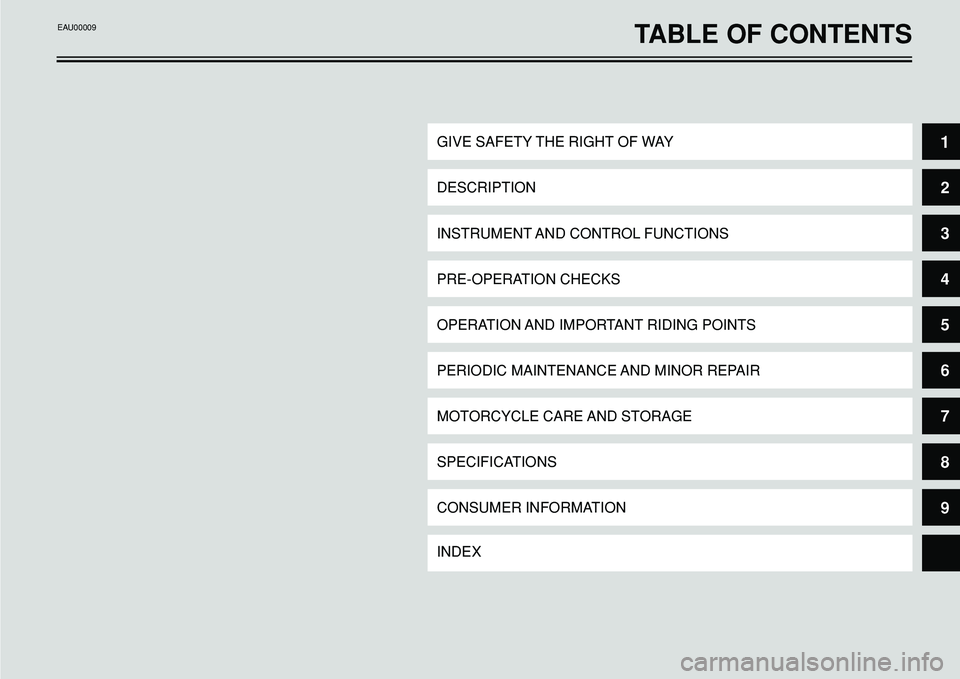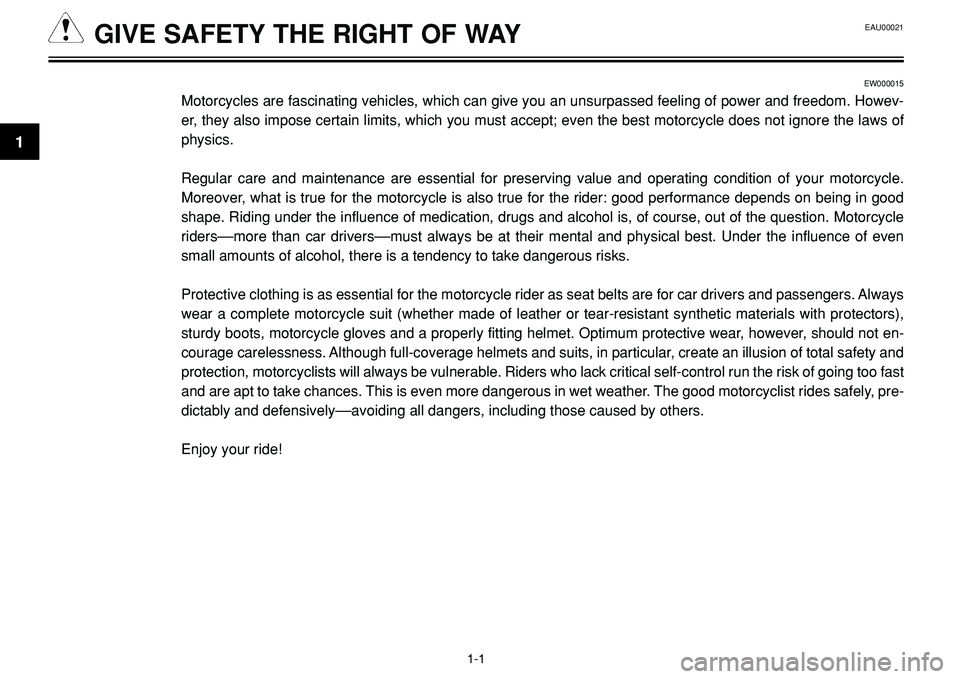2004 YAMAHA BT1100 maintenance
[x] Cancel search: maintenancePage 6 of 96

1
2
3
4
5
6
7
8
9
GIVE SAFETY THE RIGHT OF WAY
DESCRIPTION
INSTRUMENT AND CONTROL FUNCTIONS
PRE-OPERATION CHECKS
OPERATION AND IMPORTANT RIDING POINTS
PERIODIC MAINTENANCE AND MINOR REPAIR
MOTORCYCLE CARE AND STORAGE
SPECIFICATIONS
CONSUMER INFORMATION
INDEX
TABLE OF CONTENTSEAU00009
Page 8 of 96

EAU00021
1
GIVE SAFETY THE RIGHT OF WAY
1-1
EW000015
Motorcycles are fascinating vehicles, which can give you an unsurpassed feeling of power and freedom. Howev-
er, they also impose certain limits, which you must accept; even the best motorcycle does not ignore the laws of
physics.
Regular care and maintenance are essential for preserving value and operating condition of your motorcycle.
Moreover, what is true for the motorcycle is also true for the rider: good performance depends on being in good
shape. Riding under the influence of medication, drugs and alcohol is, of course, out of the question. Motorcycle
riders––more than car drivers––must always be at their mental and physical best. Under the influence of even
small amounts of alcohol, there is a tendency to take dangerous risks.
Protective clothing is as essential for the motorcycle rider as seat belts are for car drivers and passengers. Always
wear a complete motorcycle suit (whether made of leather or tear-resistant synthetic materials with protectors),
sturdy boots, motorcycle gloves and a properly fitting helmet. Optimum protective wear, however, should not en-
courage carelessness. Although full-coverage helmets and suits, in particular, create an illusion of total safety and
protection, motorcyclists will always be vulnerable. Riders who lack critical self-control run the risk of going too fast
and are apt to take chances. This is even more dangerous in wet weather. The good motorcyclist rides safely, pre-
dictably and defensively––avoiding all dangers, including those caused by others.
Enjoy your ride!
Page 17 of 96

INSTRUMENT AND CONTROL FUNCTIONS
NOTE:
Depending on the market where the
motorcycle is sold, the speedometer can
be set to either mph or km/h. When the
speedometer is set to mph, the odometer
counts in miles (1 mile = 1.61 km).Odometer and tripmeter modes
Pushing the “SET” button switches the dis-
play between the odometer mode “ODO”
and the tripmeter modes “TRIP 1” and
“TRIP 2” in the following order: ODO 6
TRIP 1 6TRIP 2 6ODO
When the fuel warning light comes on, the
display will automatically change to the fu-
el reserve tripmeter mode “TRIP F” and
start counting the distance traveled from
that point. In that case, pushing the “SET”
button switches the display between the
various tripmeter and odometer modes in
the following order: TRIP F 6TRIP 1 6
TRIP 2 6ODO 6TRIP F
To reset a tripmeter, select it by pushing
the “SET” button, and then push the “RE-
SET” button for at least one second. If you
do not reset the fuel reserve tripmeter
manually, it will reset itself automatically
and the display will return to the prior
mode after refueling and traveling several
kilometers.Oil change indicator
At the initial 1,000 km (620 mi) and every
10,000 km (6,200 mi) thereafter, the mes-
sage “OIL CHANGE” appears in the dis-
play for a few seconds when the key is
turned to “ON”, to indicate that the engine
oil should be changed.
After changing the engine oil, reset the oil
change indicator.
If the engine oil is changed before the oil
change indicator appears in the display
(i.e. before the periodic oil change interval
has been reached), the indicator must be
reset after the oil change for the next peri-
odic oil change to be indicated at the cor-
rect time.
NOTE:
When the message “OIL CHANGE”
appears in the display, be sure to change
the engine oil as soon as possible. In addi-
tion to these kilometer-based oil changes,
be sure to have a Yamaha dealer perform
the annual checks specified in the period-
ic maintenance and lubrication chart on
page 6-2.
EAU00027
3-4
3
Page 18 of 96

INSTRUMENT AND CONTROL FUNCTIONS
To reset the periodic maintenance and lu-
brication indicator:
1. Turn the key to “
B” (OFF).
2. Push the “RESET” button and hold it
down while turning the key to “
I”
(ON).Clock mode
NOTE:
The clock can only be set while the
speedometer unit is in the odometer
mode.
To set the clock:
1. Turn the key to “
I” (ON).
2. Push the “RESET” button and “SET”
button together for at least two sec-
onds.
3. When the hour digits start flashing,
push the “RESET” button to set the
hours (between 1 and 12).4. Push the “SET” button, and the first of
the two minute digits will start flash-
ing.
5. Push the “RESET” button to set the
first minute digit (between 0 and 5).
6. Push the “SET” button, and the sec-
ond of the two minute digits will start
flashing.
7. Push the “RESET” button to set the
second minute digit (between 0 and 9).
8. Push the “SET” button, and then re-
lease it to start the clock.
EAU00027
3-5
3
Page 42 of 96

6
Owner’s tool kit .............................................................. 6-1
Periodic maintenance and lubrication chart .................... 6-2
Removing and installing panels ...................................... 6-5
Checking the spark plugs ................................................ 6-5
Engine oil and oil filter element ........................................ 6-7
Final gear oil .................................................................... 6-9
Cleaning the air filter element .......................................... 6-10
Adjusting the carburetors ................................................ 6-12
Adjusting the engine idling speed .................................... 6-12
Adjusting the throttle cable free play................................ 6-13
Adjusting the valve clearance .......................................... 6-13
Tires ................................................................................ 6-14
Cast wheels .................................................................... 6-16
Adjusting the clutch lever free play .................................. 6-17
Adjusting the brake pedal position .................................. 6-18
Checking the front and rear brake pads .......................... 6-19
Checking the brake fluid level .......................................... 6-19
Changing the brake fluid .................................................. 6-21
Adjusting the shift pedal position .................................... 6-21
Checking and lubricating the cables ................................ 6-22Checking and lubricating the
throttle grip and cable ...................................................... 6-22
Checking and lubricating the brake and shift
pedals .............................................................................. 6-23
Checking and lubricating the brake and
clutch levers .................................................................... 6-23
Checking and lubricating the sidestand .......................... 6-24
Checking the front fork .................................................... 6-24
Checking the steering ...................................................... 6-25
Checking the wheel bearings .......................................... 6-25
Battery ............................................................................ 6-26
Replacing the fuses ........................................................ 6-28
Replacing the headlight and auxiliary light bulb .............. 6-29
Replacing a turn signal light bulb .................................... 6-31
Replacing the tail/brake light bulb .................................... 6-31
Replacing the license plate light bulb .............................. 6-32
Front wheel ...................................................................... 6-32
Rear wheel ...................................................................... 6-33
Troubleshooting .............................................................. 6-35
Troubleshooting chart ...................................................... 6-36
PERIODIC MAINTENANCE AND MINOR REPAIREAU00462
Page 43 of 96

EAU00462PERIODIC MAINTENANCE AND MINOR REPAIR
1EAU00464
Safety is an obligation of the owner. Peri-
odic inspection, adjustment and lubrication
will keep your vehicle in the safest and
most efficient condition possible. The most
important points of inspection, adjustment,
and lubrication are explained on the fol-
lowing pages.
The intervals given in the periodic mainte-
nance and lubrication chart should be sim-
ply considered as a general guide under
normal riding conditions. However, DE-
PENDING ON THE WEATHER, TER-
RAIN, GEOGRAPHICAL LOCATION,
AND INDIVIDUAL USE, THE MAINTE-
NANCE INTERVALS MAY NEED TO BE
SHORTENED.
EW000060WARNING0
If you are not familiar with motorcycle
maintenance work, have a Yamaha
dealer do it for you.
1. Owner’s tool kit
EAU01129
Owner’s tool kit
The owner’s tool kit is located inside the
storage compartment (see page 3-13 for
storage compartment opening proce-
dures).
The service information included in this
manual and the tools provided in the own-
er’s tool kit are intended to assist you in
the performance of preventive mainte-
nance and minor repairs. However, addi-
tional tools such as a torque wrench may
be necessary to perform certain mainte-
nance work correctly.
NOTE:
If you do not have the tools or experience
required for a particular job, have a Yama-
ha dealer perform it for you.
EW000063WARNING0
Modifications not approved by Yamaha
may cause loss of performance and
render the vehicle unsafe for use. Con-
sult a Yamaha dealer before attempting
any changes.
6-1
6
Page 44 of 96

EAU00462PERIODIC MAINTENANCE AND MINOR REPAIR
EAU03685
Periodic maintenance and lubrication chart
NOTE:
•The annual checks must be performed every year, except if a kilometer-based maintenance is performed instead.
•From 50,000 km, repeat the maintenance intervals starting from 10,000 km.
•Items marked with an asterisk should be performed by a Yamaha dealer as they require special tools, data and technical skills.
6-2
6
ODOMETER READING (x 1,000 km)ANNUALN0. ITEM CHECK OR MAINTENANCE JOB
1 10203040CHECK
1*Fuel line•Check fuel hoses and vacuum hose for cracks
√√√√ √or damage.
2*Fuel filter•Check condition.√√
•Check condition.
√√
3 Spurk plugs•Clean and regap.
•Replace.√√
4
*Valves•Check valve clearance.
√√√√•Adjust.
5 Air filter element•Clean.√√•Replace.√√
6 Clutch•Check operation.
√√ √√ √
•Adjust.
•Check operation,fluid level and vehicle
for fluid leakeage. √√ √√ √ √
7*Front brake
(See NOTE on page 6-4).
•Replace brake pads. Whenever worm to the limit
Page 45 of 96

EAU00462
ODOMETER READING (x 1,000 km)ANNUALN0. ITEM CHECK OR MAINTENANCE JOB
1 10203040CHECK
•Check operation, fluid level and vehicle
for fluid leakage. √√ √√ √ √
8*Rear brake(See NOTE on page 6-4).
•Replace brake pads. Whenever worm to the limit
9*Brake hoses•Check for cracks or damage.√√√√ √•Replace. (See NOTE on page 6-4). Every 4 years
10*Wheels•Check runout and for damage.√√√√
•Check tread depth and for
damage.
11
*Tires•Replace if necessary.√√√√
•Check air pressure.
•Correct if necessary.
12*Wheel bearings•Check bearing for looseness or damage.√√√√
13*Swingarm•Check operation and for excessive play.√√√√•Lubrificate with lithium-soap-based grease. Every 50,000 km
14*Steering bearings•Check bearing play and steering for roughness.√√ √√ √•Lubrificate with lithium-soap-based grease. Every 20,000 km
15
*Chassis fasteners•Make sure that all nuts, bolts and screws are properly
√√√√ √tightened.
16 Sidestand•Check operation.
√√√√ √
•Lubricate.
17
*Sidestand
•Check operation and for oil leakage.√√ √√ √ √switch
18*Front fork•Check operation and for oil leakage. √√√√
19
*Rear shock absorber
•Check operation and shock absorber for oil leakage.√√√√
assembly
PERIODIC MAINTENANCE AND MINOR REPAIR
6-3
6